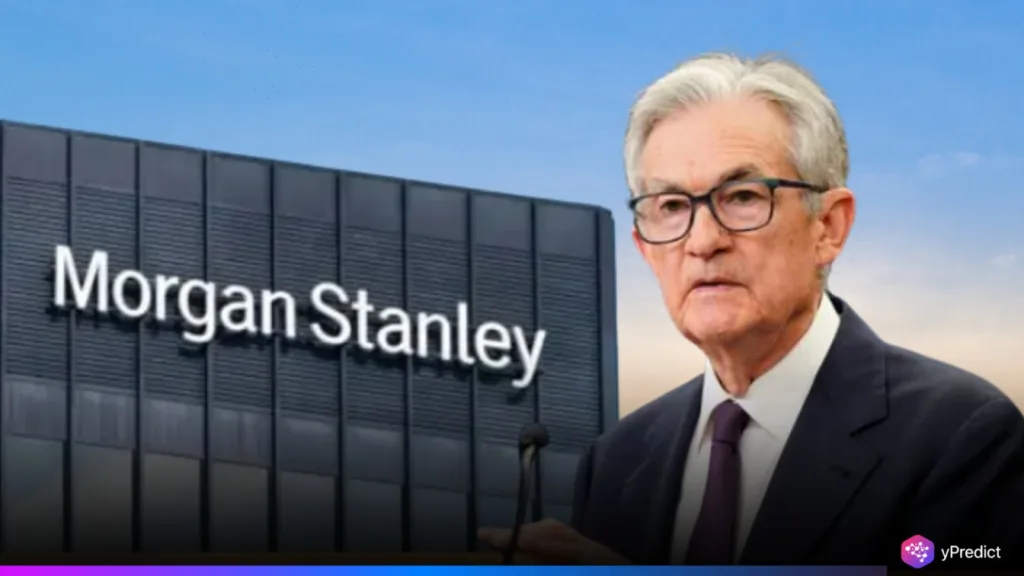
Morgan Stanley has updated its economic outlook and has aligned this outlook with the Federal Reserve’s recent signals, signaling a steady, though cautious, mindset, after Jerome Powell’s speech on August 22, 2025, at Jackson Hole. This update clearly illustrates how the heavyweights on Wall Street are now looking to gradual rate cuts as the best opportunity to obtain a soft landing for the U.S. economy. Morgan Stanley and J.P. Morgan both anticipate easing in the months ahead, aligning with Powell’s message that policy must maintain a balance between growing the economy and controlling inflation.
Rate Cuts Expected in September and December
Morgan Stanley expects two cuts of 25 basis points in their respective monetary policy grooves, one in September and one in December 2025. Jerome Powell told the crowd of policymakers in Jackson Hole that all options are available, but they would stay measured given they will be employing an action-oriented view of interest rate options to bedding air with stability and inflation dampening.
Morgan Stanley’s economists describe those cuts as not meant to flood the economy with stimulus, but rather demonstrate the Federal Reserve can stay consistent with growth without inciting an additional price scare. The Peterson Institute said the close coordination between Morgan Stanley and the Federal Reserve provides a view where conservative, step-wise measures are the preferred option going forward in an environment of enduring inflation. Markets responded positively following the anticipation, and investors were encouraged by signs of a definitive route to follow after months of uncertainty.
Soft Landing Strategy Gains Traction
“Soft Landing” is now at the forefront of economic discussions, with Jerome Powell reinforcing the belief it could happen. Morgan Stanley agrees with the Federal Reserve’s perspective that easing gradually will put the economy into a stable position. They believe this will be accomplished with slow moderation, which should allow inflation to relax while holding on to labor markets.
Powell’s remarks were made in a way to assume the Federal Reserve wishes for no recession while also containing the many risks associated with the accumulated fruits of ongoing inflation. In fact, the soft landing narrative has exploded as a rallying point on Wall Street; Morgan Stanley’s adjusted expectations reinforce the notion that, at the moment, policymakers and markets are walking together.
Labor Market Risks and Inflation Pressures
As optimism builds, both Jerome Powell and Morgan Stanley identified potential pitfalls. Powell said wage growth is good for workers but will re-ignite inflation without ongoing scrutiny. Morgan Stanley said some inflation remains sticky in parts of the economy despite all the progress made over the past year.
The Federal Reserve’s message, during the Jackson Hole-Massachusetts economy symposium, was that labor market interactions will be a key player in their policy dilemma. Economists at Morgan Stanley warned that strong labor demands will challenge the job of restoring order to inflation. The left hand and right hand of the Federal Reserve and Morgan Stanley both say that the Federal Reserve’s September rate cut will be largely contingent upon employment data and inflation indicators. Balancing rate cuts on the forward curve and risks reflects how complicated today’s economy truly is.
J.P. Morgan’s Parallel Forecast Adds Weight
J.P. Morgan Research published its own forecast with Morgan Stanley, and their forecast indicated the federal funds rate would be between 3.25% and 3.5% in the first quarter of 2026. This specific forecast implicitly supported the Federal Reserve’s gradualism and, therefore, also supported Powell’s more cautious mindset as well. With both J.P. Morgan and Morgan Stanley forecasts indicating the Federal Reserve will keep a relatively flexible policy, each major financial institution is likely to consider the inherent uncertainties that will continue to present themselves as inflation trends change and global trade adjusts. The impact of tariffs, pressures on the labor market, and core inflation are vital to this discussion.
The fact that Morgan Stanley and J.P. Morgan’s forecasts point in almost the same direction indicates that those institutions are building consensus in the Wall Street community, which could make for a little less volatility in the financial markets during the months ahead. Morgan Stanley’s alignment with the Federal Reserve indicates that at least two major financial institutions view the coming worries as a matter of managing the relevant risks, not intervening aggressively.







